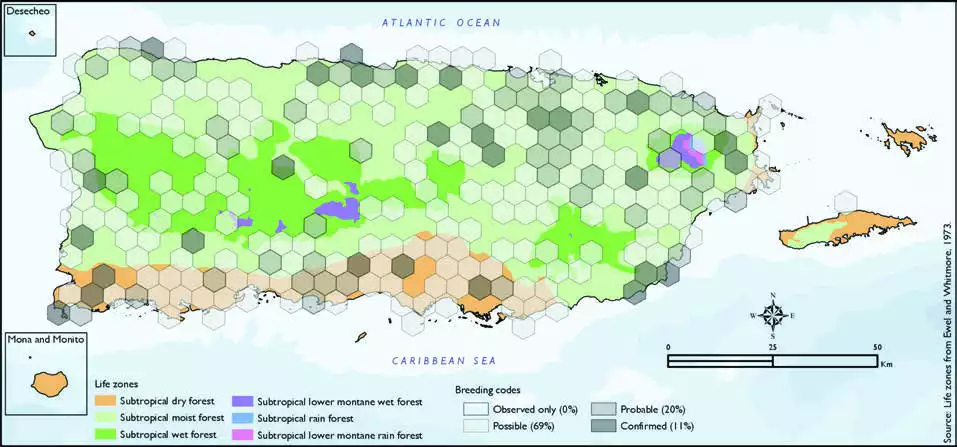Antillean Mango
Description
The Antillean mango (Anthracothorax dominicus) is a species of hummingbird in the family Trochilidae.
It is found on the Caribbean islands of Hispaniola (both the Dominican Republic and Haiti), Puerto Rico, the British Virgin Islands, and the Virgin Islands, U.S..
Females and young birds are white-gray breasted. Adult females have a red-terracota colored tail with small white tips at the end.
Distribution & Habitat
The Antillean Mango is a Caribbean endemic and common
resident species in Puerto Rico
(Raffaele and others 1998),
especially in the lowlands
(Oberle 2018), and it is an
extremely rare former breeder
on Vieques (Gemmill 2015). This
species is the most abundant
hummingbird in forested
habitats, scrub, clearings in dry
and moist forests in the south
coasts, and the hills of northern
Puerto Rico (Biaggi 1997, Oberle
2018), and it is also present in
gardens and coffee plantations
(Raffaele and others 1998). The
atlas fieldwork yielded a total of
401 records within 253 hexagons or 53 percent of the 479 total
hexagons (see map). Of the 253
hexagons where this species
was found, breeding met the
atlas definition of confirmed in
11 percent (28) of the hexagons,
probable in 20 percent (51),
and possible in 69 percent (174)
(see map). Antillean Mango distribution. The map shows the highest breeding code by hexagon and overlaying the ecological life zones in
Puerto Rico. Note: percentages may not total 100 due to rounding.

Breeding Habits
The Antillean Mango constructs a cup-shaped nest on a branch,
from March to August, according
to previously published reports
(Raffaele and others 1998).
Atlas results indicate that this
species breeding season extends
throughout the year, but it is
most active from March to July 81Antillean Mango/Zumbador Dorado (see chart). Results show that this species uses all ecological
life zones to breed, but breeding
occurs most commonly in the
subtropical moist forest life zone
(65 percent of the hexagons),
followed by the subtropical dry
and subtropical wet forest life
zones (23 and 12 percent of the
hexagons, respectively) (see
table and map). Breeding was
also reported for one hexagon
in the subtropical rain forest
life zone.
Conservation
The population trend for the Antillean Mango across its distribution range is unknown,
and since it is relatively common,
it is listed as a species of least
concern by the IUCN (BirdLife
International 2016), while locally
this species is not listed in any
of the threatened categories used
by PRDNER and USFWS. The
Antillean Mango, once formerly
common on Vieques (Wetmore
1916), declined with the spread
of the Green-throated Carib
on this island (Gemmill 2015).
Whether the mango population
decline on Vieques is attributable
to competition with the Green-
throated Carib and/or due to
habitat change on this island is unknown. However, given this
history of the mangos decline on
Vieques and the relatively recent
arrival of the Green-throated
Carib on Puerto Rico, it would
be prudent to carefully monitor
the mango population on
Puerto Rico. In Puerto Rico, the
Antillean Mango has a protected
habitat in land of 12 percent or
720 km2 of the total area covered by the hexagons where evidence
of breeding was found for this
species (6050 km2).
Related Species
Family:
hummingbird